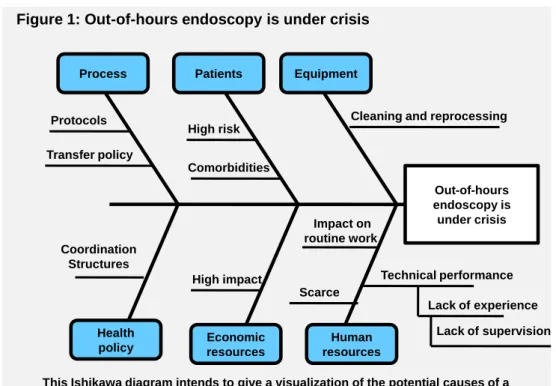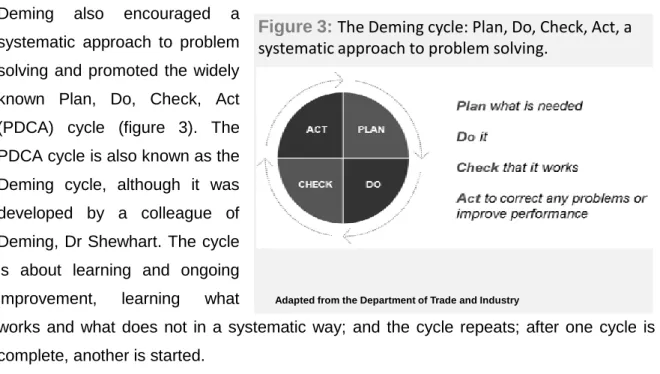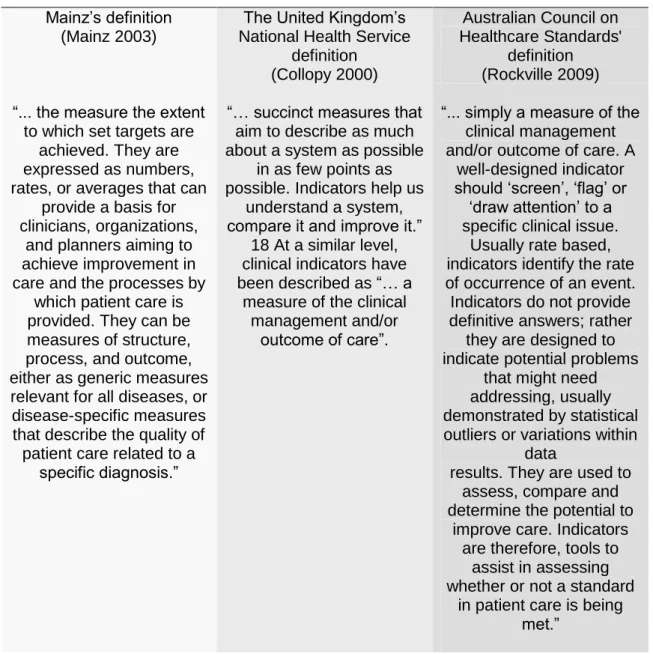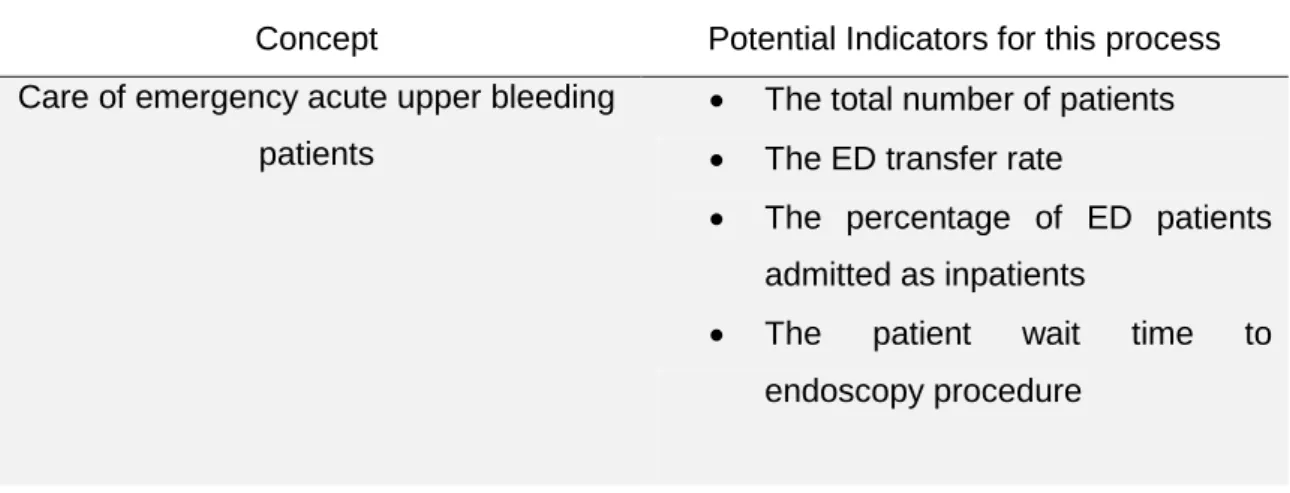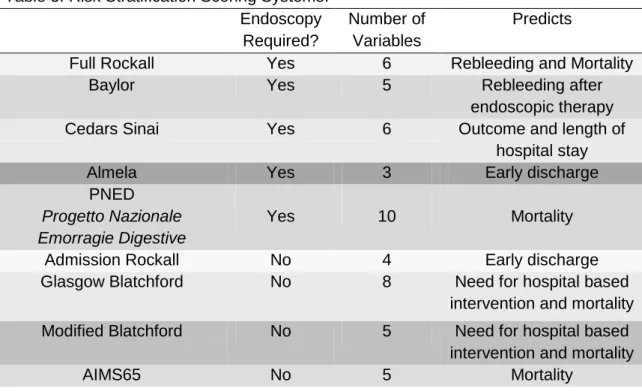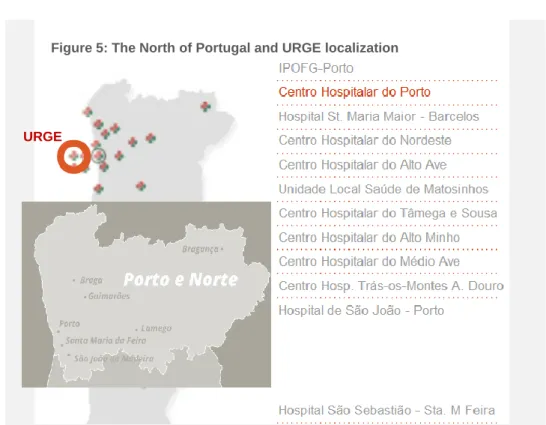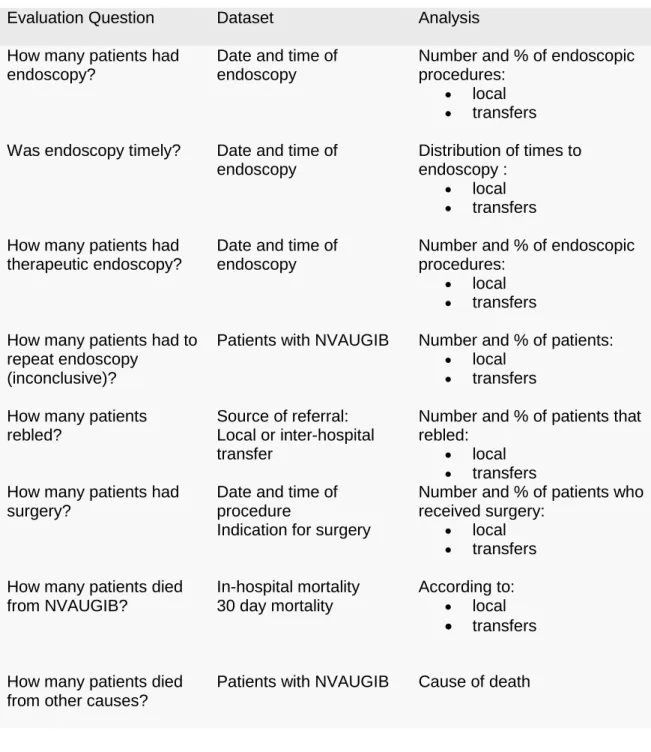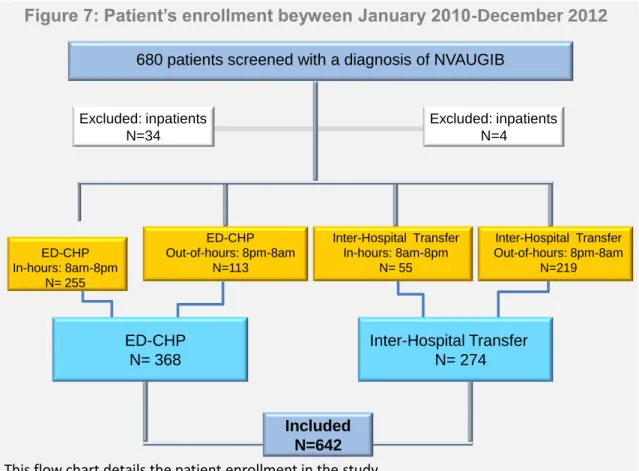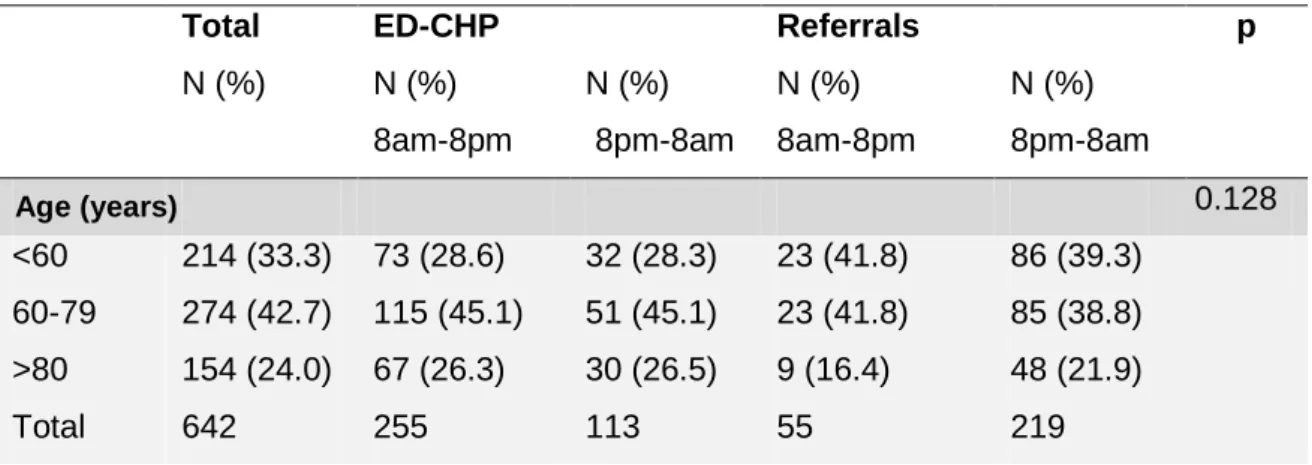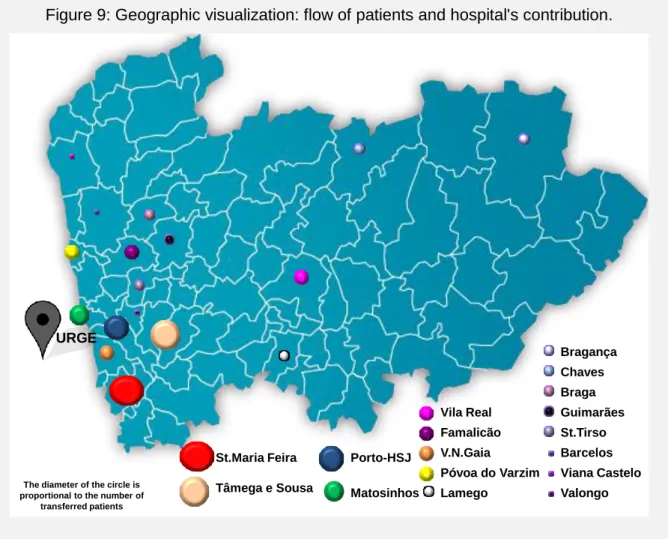ISABEL MARIA TEIXEIRA DE CARVALHO PEDROTO
TESE DE DOUTORAMENTO APRESENTADA AO INSTITUTO DE CIÊNCIAS
BIOMÉDICAS ABEL SALAZAR DA UNIVERSIDADE DO PORTO EM CIÊNCIAS
MÉDICAS
2014
ACUTE UPPER GASTROINTESTINAL BLEEDING: USING
QUALITY DATA FOR OPERATIONAL AND CLINICAL
Legislação e regulamentos aplicáveis ao Doutoramento em Ciências Médicas:
Decreto-Lei nº 74/2006, de 24 de março, com a redação dada pelos Decretos-Lei nº107/2008 e 230/2009, de 25 de junho e 14 de setembro. Regulamento geral dos terceiros ciclos de estudos da Universidade do Porto, aprovado pelo despacho reitoral GR.05/11/2009, de 24 de novembro. Deliberação n.º 3218/2009 de 24 de novembro do Reitor da Universidade do Porto, publicada em Diário da República, 2.ª série, n.º 232 de 30 de novembro. Regulamento Específico do Doutoramento em Ciências Médicas aprovado da Comissão Coordenadora do Conselho Científico do Instituto de Ciências Biomédicas Abel Salazar da Universidade do Porto, a 21 de abril de 2010. A capa da tese obedece ao manual de imagem da Reitoria da Universidade do Porto.
ISABEL MARIA TEIXEIRA DE CARVALHO PEDROTO
ACUTE UPPER GASTROINTESTINAL BLEEDING: USING
QUALITY DATA FOR OPERATIONAL AND CLINICAL
IMPROVEMENT
Tese de Candidatura ao grau de Doutor em
Ciências Médicas submetida ao Instituto de
Ciências
Biomédicas
Abel
Salazar
da
Universidade do Porto.
Orientador:
Doutor Jorge Alberto Areias
Categoria – Professor Catedrático Aposentado
Afiliação
– Instituto de Ciências Biomédicas
Abel Salazar da Universidade do Porto.
Coorientadores:
Doutora Suzete Gonçalves
Categoria – Investigadora
Afiliação – Centro de Estudos e Investigação em
Saúde na Universidade de Coimbra
Doutor Mário Dinis Ribeiro
Categoria – Professor Catedrático Convidado
Afiliação
– Faculdade de Medicina da
Universidade do Porto
À memória do meu pai, pela honradez, verticalidade, coragem e determinação, pelo exemplo do seu caráter e por tudo o que me legou.
À minha mãe, pelo seu incondicional amor e dedicação.
Aos meus irmãos, com os quais comungo de uma fraternidade indestrutível.
/ Preface
7
PREFACE
In October 2006, in the north of Portugal, as a result of human and economic constraints, the out-of-hours gastroenterology emergency was reviewed, reorganized and restructured, by allocating in a single endoscopy unit, gastroenterologists from eight hospitals of the district of Oporto. Presenting this data is the product of my five years of work, as responsible for the management of this out-of-hours endoscopy regional center.
Over the years, as healthcare has become more complex, as quality management has evolved, and the organization where I work has made a strong commitment to the process of quality improvement and patient safety, my understanding of what managing quality means has growth as well. My journey began as a quality risk manager, ten years ago. I was not trained to ask questions, sometimes difficult questions, nor to use data to give answers; at that time, clinical indicators and clinical audit were, for me, a complete mystery. After the implementation of the quality department, for which I was responsible from 2006-2009, I quickly realized that quality information, clinical and non-clinical, can and must be used for daily operations; that it all begins with measures which must be integrated into every aspect of care, so that each aspect can be evaluated, understood and improved. I was extremely fortunate that the hospital board believed in quality and contributed their time to ensuring that the institution continuously strived toward excellence; as well, all the professionals with whom I worked, which always enthusiastically engaged in new projects.
As a gastroenterologist, the issues of quality and patient safety, especially in the emergency care setting, continued to challenge me and inspire me personally and professionally. On the other hand, as responsible for the coordination of this emergency regional model, I asked myself: is this system fair in terms of accessibility, safety and costs? The answer, again, was measures.
Although it seems intuitive that many efficiency strategies may lead to cost savings, some quality drives may lead to increased expenditure. My first clinical audit in acute upper gastrointestinal bleeding, demonstrated that a systematic critical analysis at all levels of patient's care was needed. This has raised some crucial questions in my mind which I tried to answer in my research.
/ Preface
8
I wrote this thesis to fill what I perceived as a critical gap in healthcare services; to understand the value of data and use them in the whole process of care, as the basis for delivering quality care and try to overcome the economic constraints.
/ Acknowledgments
9
ACKNOWLEDGMENTS
Em janeiro de 1989 cheguei pela primeira vez ao Hospital de Santo António onde encontrei o saudoso Dr. Soares de Sousa, com quem tive o privilégio de trabalhar no serviço de medicina. Os seus ensinamentos, as suas palavras de estímulo, a sua amizade, fizeram com que sentisse o Hospital de Santo António como aquele que viria a tornar-se a minha casa de sempre.
Um ano depois integrei o serviço de Gastrenterologia então dirigido pelo Dr. Amílcar Mascarenhas Saraiva, clínico por quem nutro profunda admiração pela forma como sempre me tratou, pelo rigor que era seu apanágio e pela amizade que desde então perdura. Teve um papel muito importante nos primeiros anos da minha formação e por isso lhe devo um enorme tributo de gratidão e apreço.
Foi meu orientador de internato o Professor Doutor Jorge Areias, a quem dirijo as minhas primeiras e sentidas palavras de agradecimento.
Sempre me incentivou e estimulou para iniciar o doutoramento. Espero com esta tese poder expressar-lhe a dimensão e profundidade do meu reconhecimento e amizade. Ao Dr.Carlos Pinho pelo exemplo de persistência, determinação e coragem.
Ao Dr. Sollari Allegro, atual Presidente do Conselho de Administração e meu colega gastroenterologista, devo também um especial tributo. Devo-lhe muito do que aprendi no âmbito da Gastrenterologia, em particular no domínio das técnicas e no manuseamento da hemorragia digestiva. Foi o Dr. Sollari Allegro que me convidou para assumir as funções de gestora de risco clinico e, mais tarde, para dirigir o departamento de qualidade.
As tarefas de que fui incumbida despertaram em mim o gosto e interesse pela gestão do risco clínico e pela importância da qualidade, atributos essenciais da gestão hospitalar de excelência.
Pela amizade com que me distinguiu ao longo destes anos e que sempre procurei retribuir, o meu profundo agradecimento ao Dr. Sollari Allegro que é também para mim e para todos os que o conhecem um edificante exemplo de coragem, força e inesgotável pertinácia.
Uma palavra de fraternal amizade a todos os meus colaboradores no departamento de qualidade que dirigi durante 3 anos.
/ Acknowledgments
10
Foi um trabalho árduo, estimulante, desafiante, em que foi preciso vencer inúmeros obstáculos, mas sempre pautado por um forte espírito de equipa, por um acrisolado sentido de missão e por um entusiasmo contagiante ao serviço da mudança e de uma cultura organizativa moderna, eficiente e humanista.
Cabe aqui também um agradecimento muito especial dirigido ao Prof. Doutor Martins da Silva, cujo convite para ser sua adjunta na direção clínica me fez crescer e entender ainda mais a necessidade de uma governação clínica na qual os médicos devem liderar o processo e assumirem-se como os principais protagonistas da mudança.
Estou igualmente grata à Professora Doutora Suzete Gonçalves, minha coorientadora, e de quem recebi preciosos ensinamentos enquanto discente das suas aulas de economia da saúde no âmbito da pós-graduação em gestão para médicos, o que muito contribuiu para a minha formação e para expandir os horizontes do meu conhecimento.
Ao Professor Doutor Mário Dinis-Ribeiro pelo estímulo constante e pela forma como tem sabido prestigiar a gastroenterologia portuguesa em Portugal e na Europa.
A todos os elementos do meu Serviço, médicos, enfermeiros, assistentes técnicos e operacionais, pela colaboração no desempenho deste trabalho e pelas provas de solidariedade e amizade de que deram mostras ao longo destes anos.
A todos os colegas que integram a urgência regional de Gastrenterologia, pela participação ativa na recolha de dados e desempenho ímpar neste modelo organizativo. A todos os elementos do serviço de urgência e das unidades intermédia e de cuidados intensivos, da área médica e cirúrgica, que tão eficazmente lidam com estes doentes e colaboram com o serviço de gastrenterologia.
Uma palavra muito especial de agradecimento ao Conselho de Administração do Centro Hospitalar do Porto pela compreensão dos objetivos do trabalho, pela disponibilidade e palavras de encorajamento permanente, o que em muito concorreu para a sua realização.
Ao Professor Doutor Cardoso de Oliveira, o meu reconhecimento por todos os ensinamentos, pelos desafios para integrar novos projetos na área da qualidade clínica, como a Associação para a Segurança dos Doentes, mas sobretudo, pela compreensão e pela forma carinhosa como sempre me tratou.
A todos os meus amigos, uma palavra especial de agradecimento pela paciência e amizade.
/ Acknowledgments
11 A toda a minha família, a expressão do meu amor.
/ List of Published or Accepted for Publication Papers
13
LIST OF PUBLISHED OR ACCEPTED FOR PUBLICATION PAPERS
All papers are referred to in the text by the corresponding Roman numeral. The papers are presented in the chronological order of their production:
Order Description
Order Description
Paper I Pedroto I, Dinis-Ribeiro M , Ponchon T. Is timely endoscopy the answer
for cost-effective management in acute upper gastrointestinal bleeding? Published in Endoscopy 2012; 44(08): 721-722
Paper II Pedroto I, Amaro P, Romãozinho JM. Health systems organization for
emergency care.
Published in Best Practice & Research Clinical Gastroenterology 27 (2013) 819–827
Paper III Pedroto I, Maia L, Salgueiro P, Teles de Sampaio E, Küttner
Magalhães R, Magalhães MJ, Pinto R, Dias C, Dinis-Ribeiro M. Out-of-Hours Endoscopy for Non-Variceal Upper Gastrointestinal Bleeding Accepted for publication in Scandinavian Journal of Gastroenterology Manuscript ID SGAS-2014-0531.R1: proofs revised.
/ List of Abbreviations
15
LIST OF ABBREVIATIONS
AUGIB Acute upper gastrointestinal bleeding CBA Cost-benefit analysis
CEA Cost-effectiveness analysis CHP Centro Hospitalar do Porto CIs Clinical Indicators
CUA Cost-utility analysis
ED Emergency department
ED-CHP Emergency department of Centro Hospitalar do Porto
EGD Upper endoscopy
ENERGIB European Study of Nonvariceal upper gastrointestinal bleeding GBS Glasgow Blatchford Score
GRS Global Rating Scale IOM Institute of Medicine
NHS Britain's National Health Service
NVAUGIB Non-variceal acute upper gastrointestinal bleeding PDCA Plan, Do, Check, Act cycle
PUB Peptic ulcer bleeding QALYs Quality-adjusted-life-years
QI Quality Improvement
URGE Regional Gastroenterology Emergency WHO World Health Organization
/ List of Figures and Tables
17
LIST OF FIGURES
Figure 1 Out-of-hours endoscopy is under crisis: an Ishikawa diagram clarifies the potential root causes of the problem
30 Figure 2 The quality dimensions proposed by the Institute of Medicine 58 Figure 3 The Deming cycle: Plan, Do, Check, Act, a systematic approach to
problem solving
65 Figure 4 Factors determining the outcome of care in health care delivery 81
Figure 5 The North of Portugal and URGE localization 111
Figure 6 Emergency check sheet 119
Figure 7 Patient enrollment between January 2010-December 2012 133 Figure 8 Pareto diagram: referrers hospitals versus the number of patients 134 Figure 9 Geographic visualization: flow of patients and hospital's contribution 135
Figure 10 Planning after EGD 143
Figure 11 Patient workflow described as a multi-step process: visualizing the patient's journey
147 Figure 12 Before and After the Model‘s implementation and assessment 182
LIST OF TABLES
Table 1 The gurus and their approach to quality improvement 64
Table 2 The seven basic tools of quality 66
Table 3 Definitions of clinical indicators 72
Table 4 Example of clinical indicator's concept 73
Table 5 Risk Stratification Scoring Systems 103
Table 6 The evaluation framework used: how was the service used 117 Table 7 The evaluation framework used: how was the service provided 118
Table 8 Baseline characteristics of patients and data recorded 124
Table 9 Overall results: age groups vs. admission status 134
Table 10 Overall results: the demand according to the year and month of the year vs. time and admission status
136 Table 11 Overall results: the demand according to weekday and weekend vs.
time and admission status
138
Table 12 Overall results - Patient flow: Lead time 139
Table 13 Overall results: Patients characteristics for NVAUGIB and in sub-groups according to time and admission status
140 Table 14 Overall results: Patients outcomes for NVAUGIB and in sub-groups
according to time and admission status
144
/ Summary
19
SUMMARY
Measurement of quality is an important area of the healthcare system. But we have to improve the way we look at quality within organizations and to invest in understanding the information across services. This perspective is essential if new models of care are implemented and intend to be successful. In northern Portugal, an out-of-hours endoscopy regional centre was set up in one tertiary trust in Oporto, o Centro Hospitalar do Porto.
Overall, the research discussed in this thesis explored the aspects of non-variceal acute upper gastrointestinal bleeding management in the real-life context of this regionalized emergency healthcare model. During a 3 year period (January 2010 to December 2012), data from consecutive outpatients (n=332) with non-variceal acute upper gastrointestinal bleeding, admitted or transferred, were prospectively collected, analyzed and compared. The results illustrate the model's effectiveness and the challenges in understanding and managing the all process of care, necessary for providing high-quality care. Median time to out-of-hours endoscopy was 6h for direct admissions and 7.7h for transferred patients; 90% of the procedures were performed in less than 24h. Rebleeding, 30 day mortality and need for surgery were respectively 9.8%, 7.4% and 6.6% and were not significantly different between the two groups. Age, malignancy and an admission Rockall risk score were predictors of in-hospital mortality, whatever the admission status. In the transferred group, patients with 80 years old or more showed a 11-fold significantly increased risk of rebleeding, than younger patients. Patients transferred with malignancy, a high risk clinical Rockall score and more than 80 years old presented a probability of 30-day mortality, three, six and sixteen times greater. The results emphasize the importance of supporting healthcare providers with tools that enable them to decide in their daily practice whether to comply with standard of care and simultaneously respond to economic constraints.
This regionalization model has overcome the problem of emergency provision and demonstrated equity, safety, efficacy, effectiveness and availability of appropriately trained and experienced endoscopy staff.
We believe this may fit in a larger opportunity to improve processes and outcomes in acute upper gastrointestinal bleeding and other clinical contexts or regions. Nevertheless, it is important to determine, in the near future, the impact of regionalization in the economics of hospitals within the system.
/ Resumo
21
RESUMO
Actualmente é exigido um esforço constante de melhoria contínua da qualidade às organizações de saúde. Mas temos, cada vez mais, de avaliar a qualidade dentro das organizações, melhorando a informação e a comunicação. Esta perspectiva é essencial para que novos modelos de gestão sejam implementados e bem sucedidos. No norte de Portugal, foi criada uma urgência regional noturna de gastrenterologia, no Centro Hospitalar do Porto.
No geral, esta dissertação analisa os cuidados prestados aos doentes no contexto das várias dimensões da qualidade. Este trabalho estuda e discute, comparativamente, os resultados obtidos em doentes admitidos diretamente nesta urgência regional com os de doentes transferidos de outros hospitais que se apresentaram com hemorragia digestiva alta não-varicosa (n = 332). Durante um período de três anos (janeiro de 2010 a dezembro de 2012), foram prospetivamente registados os dados destes doentes.
O tempo mediano para a realização de endoscopia foi de 6h para as admissões diretas e de 7,7h para os doentes transferidos e 90% dos procedimentos foram realizados nas primeiras 24 horas. A recidiva hemorrágica, a mortalidade e a necessidade de cirurgia urgente foram respetivamente de 9,8%, 7,4% e 6,6% e semelhantes nos dois grupos. A idade, a malignidade e o score clínico de Rockall foram preditores de mortalidade hospitalar, independentemente do tipo de admissão. No grupo dos doentes transferidos, os que tinham uma idade igual ou superior a 80 anos apresentaram um risco 11 vezes superior. Os doentes com neoplasia, os portadores de um elevado score de admissão de Rockall e os com mais de 80 anos tinham probabilidade de mortalidade aos 30 dias, três, seis e dezasseis vezes maior. Os resultados enfatizam a necessidade de integração de metodologias e ferramentas da gestão da qualidade na área da saúde, numa perspectiva operacional, capaz de permitir, não só a optimização dos processos mas, simultaneamente, uma gestão mais eficaz dos recursos.
Este modelo de regionalização resolveu o problema da provisão de recursos humanos e demonstrou equidade, segurança e eficiência, com a disponibilidade de uma equipa de endoscopia experiente.
Esta tese, focalizada em aspectos nucleares da gestão da qualidade, alerta para o benefício de uma abordagem integrada de gestão da qualidade na saúde, neste e noutros contextos clínicos ou noutras regiões do País. No entanto, é importante determinar, num futuro próximo, o impacto económico da regionalização nas instituições que integram o modelo.
/ Table of Contents
23
TABLE OF CONTENTS
PREFACE ... 7 ACKNOWLEDGMENTS ... 9 LIST OF PUBLISHED OR ACCEPTED FOR PUBLICATION PAPERS ...13 LIST OF ABBREVIATIONS ...15 LIST OF FIGURES ...17 LIST OF TABLES ...17 SUMMARY ...19 RESUMO ...21 TABLE OF CONTENTS ...23 CHAPTER I ...25 INTRODUCTION ...25 Ia. Context ... 27 Ib. Outline and Aims of the Thesis ... 33 Ib. Outline and Aims of the Thesis ... 35 Ib. Outline and Aims of the Thesis ... 37 Ic.Thesis Structure ... 39 CHAPTER II ...53 BACKGROUND ...53 IIa. Quality in Health Care ... 55
IIa1. Definition and Dimensions of Quality ... 55 IIa2. Quality Assessment and Improvement ... 61 IIa2.1. The History of Quality Improvement... 63 IIa2.2. Assessing and Measuring Quality in Healthcare ... 67 IIb. Non-Variceal Acute Upper Gastrointestinal Bleeding ... 83 IIb1. Occurrence and Mortality Trends ... 87 IIb2. Interventions That Work ... 95 IIb3. Interventions That Need More Study: controversies and areas of uncertainty ... 99
/ Table of Contents
24
CHAPTER III ... 107 RESEARCH METHODOLOGY ... 107 IIIa. Setting ... 109 IIIb. The Process ... 113 IIIc. Patients and Data Analysis ... 121 IIId. Statistical Analysis ... 125 CHAPTER IV ... 129 RESULTS ... 129 IVa. Overall Results ... 131 IVb. Main Results ... 145 CHAPTER V ... 171 DISCUSSION ... 171 CHAPTER VI ... 185 CONCLUSIONS ... 185 VIa. Concluding Remarks ... 187 VIb. Practical Implications ... 191 VIc. Further Research ... 195 APPENDIX ... 199 REFERENCES ... 225
CHAPTER I
INTRODUCTION
Ia. Context
Ib. Outline and Aims of the Thesis
IIc. Thesis Structure
CHAPTER I
INTRODUCTION
Ia. Context
Ib. Outline and Aims of the Thesis
IIc. Thesis Structure
/ Chapter I - Introduction
29
I. INTRODUCTION
Ia. Context
Why is this research important?
Improving the quality of services is now a key requirement within any health institution. It is about making healthcare safer, effective, patient centered, timely, efficient and equitable. In the past decade, there has been a great focus on improving the quality of health services, but the boards are being challenged to respond to the rigor imposed by economic constraints.
Furthermore, acute upper gastrointestinal bleeding (AUGIB) is one of the most common emergency medical admissions for gastroenterology and has a significant inpatient mortality of 10% that has not improved over the last two decades (van Leerdam, Vreeburg et al. 2003; Targownik and Nabalamba 2006; Lanas, Garcia-Rodriguez et al. 2009).
With our ageing population, comes a number of health challenges in this area (Yachimski and Friedman 2008). Although the overall incidence of AUGIB seems to have declined since the 1990s, the studies suggest that people aged more than 60 years constitute an increasing proportion of those presenting with AUGIB (Thomopoulos, Vagenas et al. 2004; Targownik and Nabalamba 2006; Lanas, Garcia-Rodriguez et al. 2009). Also, advanced age has been consistently identified as a risk factor for mortality in patients with AUGIB, in whom the outcome is influenced also by the presence of medical comorbidities, increased prescriptions for these comorbidities and interactions between the two (Cappell and Nadler 1995; Rockall, Logan et al. 1995; Hasselgren, Blomqvist et al. 1998; Hasselgren, Carlsson et al. 1998; Yamaguchi, Yamato et al. 2003; Baradarian, Ramdhaney et al. 2004; Thomopoulos, Vagenas et al. 2004). This calls for a timeliness and coordinated approach from diagnosis to treatment, in order to optimize favorable outcomes.
Endoscopy in AUGIB is a time-critical procedure that should be performed in the first 24h (Barkun 2010). The implementation of early discharge policies is an important issue in today´s health care, but, in these cases, necessitates a rapid diagnostic endoscopic service. So, if this procedure is performed early, may avoid expensive and unnecessary
/ Chapter I - Introduction 30 Out-of-hours endoscopy is under crisis Equipment Human resources Economic resources Patients Process Health policy High risk Comorbidities Scarce
High impact Technical performance Lack of experience Lack of supervision Protocols Coordination Structures Transfer policy
Cleaning and reprocessing
Impact on routine work Figure 1: Out-of-hours endoscopy is under crisis
This Ishikawa diagram intends to give a visualization of the potential causes of a problem called out-of-hours endoscopy.
inpatient treatment with early discharge and reduction of the length of stay. However, how urgently endoscopy needs to be done is still debated (Pedroto, Dinis-Ribeiro et al. 2012).
What is lacking in the current knowledge
Some studies have identified serious gaps within the hospital like inadequate out-of hours-service, inappropriate triage and staff shortages in the management of AUGIB (da Silveira, Lam et al. 2006; Hearnshaw, Logan et al. 2010; Jairath, Kahan et al. 2012). But outside factors affecting the hospital must also be taken into account: inadequate access of the general population to specialists; delayed ambulance service; the all structure of the delivery system (da Silveira, Lam et al. 2006). The diagram bellow clarifies the factors discriminated in the studies mentioned above, and draws attention for the need of a systemic approach (figure 1).
So far as we know, there is no information available on the clinical management of AUGIB in relation to the current organization of the emergency health care services in Portugal, namely non-variceal acute upper gastrointestinal bleeding (NVAUGIB), neither a single cause and effect scenario to address timely endoscopy in northern Portugal. And, moreover, there is not a great deal of scientific analysis on these issues.
/ Chapter I - Introduction
31 Paper I and II assess this two issues, from the endoscopy perspective to the
organizational level, which can be read at the end of this chapter.
Context of the innovation
AUGIB is a time-critical event, the care of which should be timely, patient-focused and consultant-based; a 24-hours-a-day, 7-days-a week, has the essential requirements for an emergency model of care and the service should be organized around the patient‘s needs. New models of care should be beneficial to patients and staff, rather than just being considered for purely economic or administrative reasons. But, unlike other clinical areas, cardiac or stroke care, the field of emergency care in gastrointestinal emergencies, currently lacks a uniform set of metrics which informs providers, administrators, and consumers about the status of their care. All of this calls for a coordinated approach and organizational (national, regional or local) models of care. These must become the driving force for organizing, evaluating, and facilitating medical care across the full care cycle. We found no studies directly addressing the causal relationship between all three variables of care: structure, processes and outcomes, although in some, associations between outcomes and resources could be inferred. Our review suggested that more research is needed to establish a robust and effective model of gastroenterology emergency service delivery (Pedroto, Amaro et al. 2013).
In northern Portugal, none of the institutions had sufficient resources to ensure a 24-hour gastroenterology emergency service. In October 2006, an out-of-hours endoscopy regional center was set up (Regional Gastroenterology Emergency-URGE) in one tertiary trust in Oporto covering a population of three million. This is the place where 30 consultant gastroenterologists from eight hospitals and eight nurses from the endoscopy unit are integrated as the gastroenterology emergency team, everyday from 8pm to 8am; they are responsible for handling gastroenterology emergencies, especially those requiring urgent endoscopy.
Although ppopulation-base epidemiology data are important to get insight in the actual healthcare problem, it is vital to understand the current demand, outcomes and causes of NVAUGIB to inform and improve future management of this organizational acute model of care in northern Portugal.
In northern Portugal, the management of NVAUGIB in the past decade was dependent on the organizational structure of each hospital. Until October 2006, endoscopy was
/ Chapter I - Introduction
32
performed within normal working hours only, i.e. usually the next working day after admission. The establishment of a dedicated out-of-hours endoscopy unit gave us the opportunity and clinical material to inquire whether the new model of treatment covers the various dimensions of quality in health care.
CHAPTER I
INTRODUCTION
Ia. Context
Ib. Outline and Aims of the Thesis
IIc. Thesis Structure
/ Chapter I - Introduction
35
I. INTRODUCTION
Ib. Outline and Aims of the Thesis
A
UGIB is defined as acute bleeding into the lumen of the gastrointestinal tract above the ligament of Trietz, typically presenting with haematemesis or melaena. It is the commonest emergency medical admission for gastroenterology, has an overall 30 day case mortality in the range of 2-14%, and is associated with a significant burden on health care resources. AUGIB is commonly categorized as variceal [from oesophageal or gastric varices] or non variceal bleeding. Non variceal bleeding is more common and can be further subdivided by its causes, being the peptic ulcer the most common.Quality in the health care (chapter IV) setting may be defined as the extent to which a health care service produces a desired outcome. Quality improvement (QI) is now a driving force in health care and is an essential aspect of service delivery at all levels. But, unless we measure, it‘s difficult to know exactly where we stand, what to improve and whether we have in fact achieved improvement; so, efforts to improve systems or processes must be driven by reliable data.
This thesis investigates, by covering the all process of care, the outcomes of NVAUGIB and the underlying causes and consequences, in the setting of a new regional emergency organizational model by assuming a systems perspective. We thought that this model might offer high availability and quality of care at every stage, as well as continuity between each step of an interconnected treatment process, that would reduce the patient‘s waiting time for endoscopy, speed up recovery with a multi-disciplinary approach, and manage resources in a more efficient way.
The purpose of the research substantiated in this thesis was to increase the understanding of NVAUGIB in the northern Portugal and the quality of the regional healthcare managing process, by implementing a prospective collection of data and outcome.
To fulfill the purpose of the thesis, four research questions have been posed in the context of the regional model of care. The formulation of the questions was governed by the relevance to understanding and managing NVAUGIB and the potential for healthcare QI.
/ Chapter I - Introduction
36
Research Questions
Research Question 1
The care provided in NVAUGIB was accessible and timely?
Research Question 2
The care provided in NVAUGIB was appropriate and effective?
Research Question 3
The care provided in NVAUGIB was supported by best evidence and practice guidelines?
Research Question 4
CHAPTER I
INTRODUCTION
Ia. Context
Ib. Outline and Aims of the Thesis
IIc. Thesis Structure
/ Chapter I - Introduction
39
I. INTRODUCTION
Ic.Thesis Structure
This thesis is divided into six chapters.
The first chapter starts with a description of the selected research area followed by the purpose and the research questions. These issues fall within the substance of papers I and II, the controversies around endoscopy time frame and a review of emergency models of care in emergency gastroenterology. The thesis structure is presented.
The chapter two is a presentation of the literature review, namely in the management of healthcare quality. Clarifications of the key concepts and previous studies in non-variceal acute upper gastrointestinal bleeding, in order to get a deeper insight of the subject matter can be find in this chapter.
The chapter three explains the methodology and describes the techniques used in the collection and analysis of data.
The chapter that follows contains an analysis of the empirical data followed by its presentation in paper III.
Chapter five discusses whether the aims and objectives of the study were achieved.
A summary and conclusions of the research will be presented, as well as some recommendations for management and future research, in chapter six.
/ Chapter I - Introduction
/ Chapter I - Introduction
/ Chapter I - Introduction
/ Chapter I - Introduction
/ Chapter I - Introduction
/ Chapter I - Introduction
/ Chapter I - Introduction
/ Chapter I - Introduction
/ Chapter I - Introduction
/ Chapter I - Introduction
/ Chapter I - Introduction
/ Chapter I - Introduction
CHAPTER II
BACKGROUND
IIa. Quality in Health Care
IIa1. Definition and Dimensions of Quality
IIa2. Quality Assessment and Improvement
IIa2.1. The History of Quality Improvement
IIa2.2. Assessing and Measuring Quality in Healthcare
IIb. Non-Variceal Acute Upper Gastrointestinal Bleeding
IIb1. Occurrence and Mortality Trends
IIb2. Interventions That Work
IIb3. Interventions That Need More Study: controversies and areas of
uncertainty
CHAPTER II
BACKGROUND
IIa. Quality in Health Care
IIa1. Definition and Dimensions of Quality
IIa2. Quality Assessment and Improvement
IIa2.1. The History of Quality Improvement
IIa2.2. Assessing and Measuring Quality in Healthcare
IIb. Non-Variceal Acute Upper Gastrointestinal Bleeding
IIb1. Occurrence and Mortality Trends
IIb2. Interventions That Work
IIb3. Interventions That Need More Study: controversies and areas of
uncertainty
/ Chapter II - Background
57
II. BACKGROUND
IIa. Quality in Health Care
IIa1. Definition and Dimensions of Quality
Over time, quality has been defined in several ways. Within healthcare, there is no universally accepted definition of quality. Quality of care encompasses many definitions, dependent on the author or institute defining the term, or if they are used in relation to health care or health care systems. For instance, the Portuguese National Health Service represents a universal care system run by the government's Department of Health in a structured and uniform manner. But, but for example, The United States' health care system, is operated by several different entities, including the government, managed care organizations, and insurance companies. Donabedian, the leading figure in the theory and management of quality of care, had already suggested that quality will always differ from person to person, largely dependent on ―where we are located in the system of care and on what the nature and extent of our responsibilities are‖ (Donabedian 1988).
Every healthcare organization provides a different level of quality, with higher levels of quality always correlating with the experience of those providing the care (HS 1990). High quality standards do rely heavily on a well-organized system, with real improvement in quality dependent on continuous improvement throughout the organization, through constant effort to reduce waste, rework, and complexity (Berwick 1989). The more efficient and content the work environment is, the higher the quality of care experienced by the patient.
At the present, I believe that for most of our health care professionals, the definitions of quality rely just on the technical excellence with which care is provided and the characteristics of interactions between provider and patient, as stated by Blumenthal (Blumenthal 1996).
In 1980, Donabedian defined care of high quality as ―that kind of care which is expected to maximize and inclusive measure the patient welfare, after one has taken account of the balance of expected gains and losses that attend the process of care in all its parts" (Donabedian 1980). In 1984, the American Medical Association defined high-quality care as care ―which consistently contributes to the improvement or maintenance of quality and/or duration of life"(1986). The association identified specific attributes of care that
/ Chapter II - Background
58
Figure 2: The quality dimensions proposed by the Institute of Medicine
should be examined in determining its quality, including an emphasis on health promotion and disease prevention, timeliness, the informed participation of patients, attention to the scientific basis of medicine, and the efficient use of resources. One of the most cited definitions, was formulated by the Institute of Medicine (IOM) in 1990, and defined quality as the ―degree to which health services for individuals and populations increase the likelihood of desired health outcomes and are consistent with current professional knowledge" (Lohr KN 1992). And in fact, the US health care system has been at the forefront of health care QI efforts for over a century. Dr. Ernest Amory Codman (1869– 1940), a physician at the Massachusetts General Hospital in Boston, was among the first in the developed world to highlight the problem of poor quality in health care. He subsequently set a standard for open, honest, and public evaluation of the end results of medical and hospital care (Neuhauser 1990). Since then, much work has been done in the USA by governmental agencies such as the Joint Commission on Accreditation of Healthcare Organizations and the Agency for Healthcare Quality and Research, and various professional societies. However, fourteen years ago, two reports from the IOM suggested that there was a long way to go before Americans could enjoy safe and clinically effective service (Institute of Medicine 1999; Medicine 2001). The first report, To
Err is Human estimated that nearly 44,000 Americans died each year as a result of
medical errors. More people died in a given year as a result of medical errors than from motor vehicle accidents, breast cancer, or AIDS. Total national costs of preventable adverse events were estimated to be between $ 17 billion and $29 billion. The second IOM report Crossing the Quality Chasm, asked for a fundamental change, recommending that the delivery of health care in the 21st century should be based on 6 key dimensions: 1) safety—avoid injury to patients from the care that is intended to help them; 2) timeliness—reduce waits and harmful delays; 3) effectiveness—provide services based on scientific knowledge to all who could benefit and refrain from providing services to those not likely to benefit [avoiding overuse and underuse, respectively]; 4) efficiency—avoid waste; 5) equitability—provide care that does not vary in quality because of personal characteristics such as gender, ethnicity, geographical location, and socioeconomic status; 6) patient centeredness—provide care that is respectful of and responsive to individual patient preferences, needs, and values. Other countries have faced similar challenges. The Britain's National Health Service (NHS), as constituted in 1948, was a
/ Chapter II - Background
59 universal system, funded predominantly by taxation, that made health care available to
the whole population and had a strong focus on health care QI, especially since the early 1990s. At that time, emphasis was placed on improving standards of care, and all professionals were mandated to scrutinize their practices through clinical audit. Clinical audit required professionals to look systematically at the procedures used for diagnosis, care, and treatment; to examine how associated resources were being used; and to investigate the effect care had on the outcome and quality of life for the patient. Various national and regional initiatives were launched to support these efforts and many organizations involved.
I think that one of the best definitions of quality belongs to Harteloh (Harteloh 2003): ―Quality is an optimal balance between possibilities realized and a framework of norms and values.‖ This conceptual definition reflects the fact that quality is an abstraction and does not exist as a discrete entity. Rather it is constructed based on an interaction among relevant actors who agree about standards (the norms and values) and components (the possibilities). This is in accordance with Davila's abstract definition "For many, quality health care is like beauty or pornography—they know it when they see it but they just can‘t define it" and " Ultimately, the answer to the question ―Should it be done?‖ rather than ―Can it be done?‖ will determine what quality health care is and is not" (Davila 2002; Davila 2002)).
The Portuguese National Health Plan for 2012-2016 defines quality in health as "... the provision of affordable and equitable healthcare, with an excellent professional level, taking into account the available resources, while achieving the citizen's adhesion and satisfaction. It also implies the adequacy of healthcare to the needs and expectations of citizens and the best possible performance".
In summary, there are many different definitions of quality in health care. The characteristics emphasized vary according to the perspectives of the people and the organizations offering them. What is common to all definitions is the need to see quality of care as much more than just a matter of technical skills and the supply of services. Good quality of care must also respect the perspectives and needs of the patient and meet standards in ways that are safe, effective, patient-centered, timely, efficient and equitable.
Regardless of what definition of quality of health care is used, it must be kept in mind that every system, every process and every patient are different. Those who work in health care need to find ways to make QI an integral component of everyone‘s work. This means
/ Chapter II - Background
60
investments in people, technology, and processes. Most importantly, it means the support of our leaders and their commitment. In spite of this difficulty in defining the concept, there has always been the need to measure and improve quality in health care.
CHAPTER II
BACKGROUND
IIa. Quality in Health Care
IIa1. Definition and Dimensions of Quality
IIa2. Quality Assessment and Improvement
IIa2.1. The History of Quality Improvement
IIa2.2. Assessing and Measuring Quality in Healthcare
IIb. Non-Variceal Acute Upper Gastrointestinal Bleeding
IIb1. Occurrence and Mortality Trends
IIb2. Interventions That Work
IIb3. Interventions That Need More Study: controversies and areas of
uncertainty
/ Chapter II - Background
63
II. BACKGROUND
IIa2. Quality Assessment and Improvement
IIa2.1. The History of Quality Improvement
There is no single definition of QI, and no approach appears to be more successful than another. However, there are a number of definitions that describe QI as a systematic approach that uses specific techniques to improve quality. The most important ingredient in successful and sustained improvement is the way in which the change is introduced and implemented. The key elements are the combination of a change (improvement) with a method (an approach or specific tools) to achieve a better outcome.
Understanding the basics of quality is important to our ability to improve it. Thus, this section briefly examines the main concerns that led to the pursuit of quality in industry.
During the early days of manufacturing, an operative‘s work was inspected and a decision made whether to accept or reject it. As businesses became larger, so did this role, and full time inspection jobs were created. Later on, these changes led to the birth of the separate inspection department with a ―chief inspector‖, reporting to either the person in charge of manufacturing or the works manager. With the creation of this new department, there came new services and issues, standards, training, recording of data and the accuracy of measuring equipment; the need to address defect prevention emerged. Hence the quality control department evolved, in charge of which was a ―quality control manager‖, with responsibility for the inspection services and quality control engineering.
The beginning of the 20th century marked the inclusion of ―processes‖ in quality practices. A ―process‖ is defined as a group of activities that takes an input, adds value to it and provides an output, such as when a chef transforms a pile of ingredients into a meal. Walter Shewhart, a statistician, began to focus on controlling processes in the mid–1920s, making quality relevant not only for the finished product but for the processes that created it. Shewhart recognized that industrial processes yield data and that this data could be analyzed using statistical techniques to see whether a process is stable and in control, or if it is being affected by special causes that should be fixed. They differ from product orientation in that they make quality relevant, not only for the finished product, but also, for the process that created it. At that time, Japan‘s industrial system was virtually destroyed,
/ Chapter II - Background
64
and it had a reputation for cheap imitation products. The Japanese recognized these problems and set about solving them with the help of some notable quality gurus like, Juran, Deming and Feigenbaum. In the early 1950‘s, quality management practices developed rapidly in Japan, and become a major theme in Japanese management philosophy, such that, by 1960, quality control and management had become a national issue. By the late 1960‘s/early 1970‘s Japan‘s imports into the USA and Europe increased significantly, due to its cheaper, higher quality products, compared to the Western counterparts.
In 1969 the first international conference on quality control, sponsored by Japan, America and Europe, was held in Tokyo. In a paper given by Feigenbaum, the term ―total quality‖ was used for the first time, and referred to wider issues such as planning, organization and management responsibility. Ishikawa gave a paper explaining how ―total quality control‖ in Japan was different, it meaning ―company wide quality control‖, and describing how all employees, from top management to the workers, must study and participate in quality control. The quality revolution in the West was slow to follow, and did not begin until the early 1980‘s, when companies introduced their own quality programs and initiatives to counter the Japanese success (UK Governement 2005; ASQ 2011).
A guru, by definition, is a good person, a wise person and a teacher. A quality guru should be all of these, plus have a concept and approach to quality within business that has made a major and lasting impact. Some examples of quality gurus are (table 1):
Table 1: The gurus and their approach to quality improvement.
Leader Approach
W Edwards Deming Plan, Do, Check, Act (PDCA) cycle
Joseph M Juran Quality Trilogy
Armand V Feigenbaum Total Quality Control
Kaoru Ishikawa Seven basic Tools of Quality Techniques
such as his cause and effect "fishbone" tool.
W Edwards Deming placed great importance and responsibility on management, at both the individual and company level, believing management to be responsible for 94% of quality problems. He introduced a new complete philosophy of management, statistical evidence that quality is built and the responsibility is to change from numbers to quality.
/ Chapter II - Background
65 Deming also encouraged a
systematic approach to problem solving and promoted the widely known Plan, Do, Check, Act (PDCA) cycle (figure 3). The PDCA cycle is also known as the Deming cycle, although it was developed by a colleague of Deming, Dr Shewhart. The cycle is about learning and ongoing improvement, learning what
works and what does not in a systematic way; and the cycle repeats; after one cycle is complete, another is started.
Joseph M Juran developed the quality trilogy – quality planning, quality control and QI. Good quality management requires quality actions to be planned out, improved and controlled. Juran emphasized the necessity for ongoing QI through a succession of small improvement projects carried out throughout the organization. His ten steps to QI are: build awareness of the need and opportunity for improvement; set goals for improvement; organize to reach the goals; provide training; carry out projects to solve problems; report progress; give recognition; communicate results; keep score of improvements achieved and maintain. Each person along the chain, from product designer to final user, is a supplier and a customer. In addition, the person will be a process, carrying out some transformation or activity.
Armand V Feigenbaum was the originator of ―total quality control‖, often referred to as total quality and defined as ―an effective system for integrating quality development, quality maintenance and QI efforts of the various groups within an organization, so as to enable production and service at the most economical levels that allow full customer satisfaction‖. He proposed three steps to quality: quality leadership; modern quality technology and organizational commitment.
Kaoru Ishikawa made many contributions to quality, the most noteworthy being his emphasis on the human side of quality, the Ishikawa diagram and the assembly and use of the ―seven basic tools of quality‖, as detailed in table 2:
Figure 3: The Deming cycle: Plan, Do, Check, Act, a systematic approach to problem solving.
/ Chapter II - Background
66
All these Gurus‘ concepts can apply to healthcare. The healthcare system itself is unbelievably complicated and costs have raised increasingly. Patients are demanding more and better care. Errors are widespread. Our population is aging. At times, the problems seem unsolvable.
The pursuit of healthcare quality came out of a concern for better health or lost lives as perceived by individual professionals, as Florence Nightingale. Florence Nightingale was a pioneer developer of survey instruments and in the graphical presentation of data. At a time when research reports were only beginning to include tables, Nightingale was using bar and pie charts, which were color coded to highlight key points [as high mortality rates under certain conditions] (Nightingale 1988). In recent years however, it is evident that the primary concern for quality comes from a pressing need to satisfy the customer (or patient) both in industry and healthcare. This has become the prerequisite for staying in business and most of the experts (Deming, Juran, Feigenbaum) in the field of quality have argued that focusing on quality is more beneficial than focusing on profit and consider top management involvement as vital.
Quality now, represents a system of methodologies and practices, common to healthcare and industry, and an ongoing commitment to excellence that encompasses all issues and engages all individuals within an organization.
Although the concept of quality management and its control in healthcare is not as advanced as it is in industry, this may be explained by the difference in the fundamental
Table 2: The seven basic tools of quality
Pareto analysis which are the big problems?
Cause and effect diagrams what causes the problems?
Stratification how is the data made up?
Check sheets how often it occurs or is done?
Histograms what do overall variations look like?
Scatter charts what are the relationships between factors? Process control charts which variations to control and how?
/ Chapter II - Background
67 concern for quality and the nature of industrial and healthcare processes. On the other
hand, quality approaches observed in health care have been in a more reactive form.
IIa2.2. Assessing and Measuring Quality in Healthcare
In 1996, the NEJM, started to publish a series of short series on the quality of medical care. The purpose of these series was to review the major technical concepts and issues that were pertinent to current discussions about the quality of care, to place those discussions in a political and social context, and to provide some guidance on how changes in techniques for measuring and improving quality could affect doctors and patients over the next decade (Blumenthal and Epstein 1992; Blumenthal 1996; Blumenthal 1996; Blumenthal and Epstein 1996).
Since 1997, the emphasis on quality has increased (Health 1998). The concept of clinical governance has been introduced, and all NHS organizations were required to ensure robust arrangements for it. Unlike clinical audit, which was a professional-only activity, clinical governance requires professionals to work with managers. Clinical governance is ―a framework through which NHS organizations are accountable for continuously improving the quality of their services and safeguarding high standards of care by creating an environment in which excellence in clinical care will flourish.‖ But there were still reasons to keep worried about health care quality, as summarized briefly by Rajan Madhok in 2002 (Madhok 2002). Although it is worth noting that the subject is quite complex, his analysis identified a number of contributory causes. First, the NHS was overloaded with policy matters and constant outpouring of national guidance. There was an unprecedented amount of policy material in the NHS relating not just to QI but also to other aspects of the service. Second, alongside the policy avalanche, there have been structural adjustments. These structural changes raised uncertainty and anxiety, leading to staff turnover and loss of continuity of work. Specific to the quality agenda were a number of national organizations with overlapping missions and hence confused responsibilities. Third, although there was acceptance of a commitment to creating a supportive and no punitive environment, some doctors and their leaders were afraid of a blame culture. Fourth, integrating QI efforts into mainstream work was difficult, because of the lack of robust information systems. Fifth, QI efforts were being led by experts and the practitioner left apart. Sixth, QI is a long-term program and the sense of urgency demonstrated by the media and the government has influenced the way in which events have turned out. Seventh, current arrangements for QI were not patient-centered. QI arrangements were organization specific and as such merely pass the responsibility from
/ Chapter II - Background
68
one organization to another, compromising the patient's journey. He concluded that change management in the NHS was not well understood and practiced. From this we realize that all the issues mentioned are of key importance for the implementation of any QI initiative. But, what emerges from these lessons is that it is difficult to move from theory to practice, without a strong commitment to organizational culture along with the engagement and empowerment of all professionals.
Managing organizational culture is increasingly viewed as an essential part of health system reform based on the premise that a major cultural transformation of the organization must be secured alongside structural and procedural change to deliver desired improvements in quality and performance. In fact, the culture of an organization is a key consideration in the design and implementation of QI initiatives. For example, health care cultures that emphasize group affiliation, teamwork, and coordination have been associated with greater implementation of continuous QI practices and higher functional health status in coronary artery bypass graft patients (Shortell, O'Brien et al. 1995; Shortell, Jones et al. 2000). By contrast, organizational cultures that emphasize formal structures, regulations and reporting relationships, appear to be negatively associated with QI activity (Ferlie and Shortell 2001).
An essential feature of organizational culture in health care institutions will be one that creates accountability for QI at all levels, from top-level management to individual caregivers. Another important element will be optimizing communication and social networking in an effort to break down hierarchies and divisions that limit information sharing. Clinical care is ultimately delivered to patients along relatively autonomous service lines (i.e. gastroenterology services, surgery services, oncology services), and strategies need to be developed to achieve synergy among them. In other words, a corporate culture which can be defined as 'the deeper level of basic values, assumptions and beliefs, that are shared by members of an organization (Johnson G 1984). Culture has a powerful effect on an organization and is recognized by many as the 'glue' that holds an organization together and allows it to adapt to changing environments.
In 2006, The World Health Organization (WHO), following this pattern of organizational commitment, published "Quality of care: a process for making strategic choices in health systems" and suggested that a health system should seek to make improvements in six areas or dimensions of quality, which are named and described below. These dimensions require that health care should be:
/ Chapter II - Background
69
Effective: delivering health care that is adherent to an evidence base and results in improved health outcomes for individuals and communities, based on need;
Efficient: delivering health care in a manner which maximizes resource use and avoids waste;
Accessible: delivering health care that is timely, geographically reasonable, and provided in a setting where skills and resources are appropriate to medical need;
Acceptable/patient-centered: delivering health care which takes into account the preferences and aspirations of individual service users and the cultures of their communities;
Equitable: delivering health care which does not vary in quality because of personal characteristics such as gender, race, ethnicity, geographical location, or socioeconomic status;
Safe: delivering health care which minimizes risks and harm to service users. One important concern of this document was to support the role of policy and strategy development and to be able to differentiate quality roles and responsibilities in the various parts of a system. They identified six domains which are interrelated and intended to help policy-makers to address quality issues at a more strategic level. They emphasized that the challenge to health systems is to ensure that engagement with patients and the population is at the heart of all policies and strategies for QI.
In a period of economic constraints and healthcare reforms, people demand greater quality in the health care they receive and accountability in the health care system. Evidence for the need to improve quality is widespread. Although difficult to quantify with accuracy, there is clear evidence that gaps exist between what is known to be effective and is, from the best available evidence and research, and what happens in practice.
Multiple reports indicate that variation in clinical practice is common even where agreed clinical practice guidelines exist. Wide, unwarranted variations that cannot be explained by illness severity or patient factors are frequent (Davis and Taylor-Vaisey 1997; Wennberg 2002; Buchan 2004; Buchan, Sewell et al. 2004; Grol and Buchan 2006; Evensen, Sanson-Fisher et al. 2010). Studies report high rates of inappropriate care and error during care-giving (Institute of Medicine 1999; Medicine 2001). And variability may be particular relevant in the emergency setting; the work of specialists is extremely varied because it is based not only on the available resources that can be supplied but also on the nature of unpredictable demand. The structure and organization of the department, the technology and the professional‘s level of uncertainty go head to head with a series of
/ Chapter II - Background
70
variables (morbidity, socioeconomic conditions and level of education, age, sex) during a process that lasts for a short amount of time and that requires urgent attention.
Different perspectives on quality will logically call for different approaches in its measurement and management. Thus, a special attention must be paid to how to improve the quality of care to everyone, in our everyday practice. Unfortunately, the current QI literature predominately focuses on case reports that describe projects in a single setting and do not provide the in-depth project evaluation necessary to fully understand QI in health care. Even systematic reviews of QI have a hard time reaching definitive conclusions as they generally conclude project evaluations and cannot establish whether improvements in quality occur, if improvements were present and whether those improvements were even causally related to the QI effort (Vest and Gamm 2009; Dellifraine, Langabeer et al. 2010). Also, the literature has identified: a lack of documentation about how major illnesses are treated in most health care systems; a lack of systematic outcome assessment; a lack of resource evaluation related to quality for specific diseases; persisting variations among providers in care for similar patients; for most diseases, potential quality problems and their prevalence and incidence are unknown in many countries (Chassin and Galvin 1998; Schuster, McGlynn et al. 1998).
In the health care field, measuring quality of care has traditionally relied on the structure-process-outcome framework developed by Donabedian (Donabedian 1988). Avedis Donabedian identified the three dimensions that can be utilized to assess quality of care (structure, process, and outcome) that would later become the core divisions of the Donabedian Model. ―Evaluating the Quality of Medical Care‖ became one of the most frequently cited public health-related articles of the 20th century (Donabedian 2005). Donabedian defines structure, process, and outcome, and clarifies that these categories should not be mistaken for attributes of quality, but rather they are the classifications for the types of information that can be obtained in order to infer whether the quality of care is poor, fair, or good. Furthermore, he states that in order to make inferences about quality, there needs to be an established relationship between the three categories and that this relationship between categories is a probability rather than a certainty. Structure in health care delivery can refer to the physical plant or the organizational structure. Processes are specific patient interventions performed by health care professionals and resulting in an outcome. Some examples of processes are, use and timeframe of emergency endoscopy in acute upper bleeding and patient length of stay in the emergency department. Outcomes are the result of the patient's interaction with the delivery health care system. Examples of clinical outcome measures include mortality or length of stay, readmission
